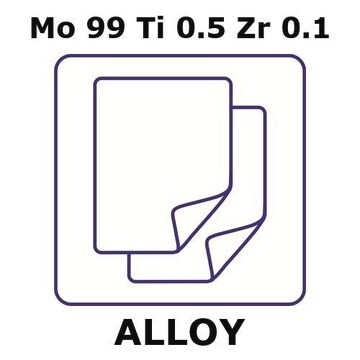266922
Molybdenum
foil, thickness 0.1 mm, ≥99.9% trace metals basis
Synonyme(s) :
Molybdenum element
About This Item
Produits recommandés
Niveau de qualité
Pureté
≥99.9% trace metals basis
Forme
foil
Résistivité
5.0 μΩ-cm, 20°C
Épaisseur
0.1 mm
Point d'ébullition
4612 °C (lit.)
Pf
2617 °C (lit.)
Densité
10.3 g/mL at 25 °C (lit.)
Chaîne SMILES
[Mo]
InChI
1S/Mo
Clé InChI
ZOKXTWBITQBERF-UHFFFAOYSA-N
Catégories apparentées
Description générale
Quantité
Code de la classe de stockage
13 - Non Combustible Solids
Classe de danger pour l'eau (WGK)
nwg
Point d'éclair (°F)
Not applicable
Point d'éclair (°C)
Not applicable
Équipement de protection individuelle
Eyeshields, Gloves, type P3 (EN 143) respirator cartridges
Certificats d'analyse (COA)
Recherchez un Certificats d'analyse (COA) en saisissant le numéro de lot du produit. Les numéros de lot figurent sur l'étiquette du produit après les mots "Lot" ou "Batch".
Déjà en possession de ce produit ?
Retrouvez la documentation relative aux produits que vous avez récemment achetés dans la Bibliothèque de documents.
Les clients ont également consulté
Articles
Combinatorial Materials Science identifies breakthrough materials through systematic exploration, aiding material discovery.
Biomedical implants are essentially foreign substances within the human body that must survive many years’ exposure to demanding mechanical and physiological conditions. Despite these challenges, metal implants have been widely used to substitute for or rebuild hard tissues such as bones and teeth.
Notre équipe de scientifiques dispose d'une expérience dans tous les secteurs de la recherche, notamment en sciences de la vie, science des matériaux, synthèse chimique, chromatographie, analyse et dans de nombreux autres domaines..
Contacter notre Service technique



